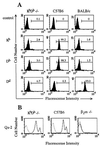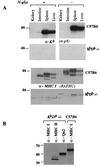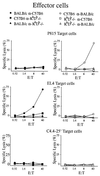Major histocompatibility complex (MHC) class I KbDb -/- deficient mice possess functional CD8+ T cells and natural killer cells
- PMID: 9770513
- PMCID: PMC22858
- DOI: 10.1073/pnas.95.21.12492
Major histocompatibility complex (MHC) class I KbDb -/- deficient mice possess functional CD8+ T cells and natural killer cells
Abstract
We obtained mice deficient for major histocompatibility complex (MHC) molecules encoded by the H-2K and H-2D genes. H-2 KbDb -/- mice express no detectable classical MHC class I-region associated (Ia) heavy chains, although beta2-microglobulin and the nonclassical class Ib proteins examined are expressed normally. KbDb -/- mice have greatly reduced numbers of mature CD8+ T cells, indicating that selection of the vast majority (>90%) of CD8+ T cells cannot be compensated for by beta2-microglobulin-associated molecules other than classical H-2K and D locus products. In accord with the greatly reduced number of CD8+ T cells, spleen cells from KbDb -/- mice do not generate cytotoxic responses in primary mixed-lymphocyte cultures against MHC-disparate (allogeneic) cells. However, in vivo priming of KbDb -/- mice with allogeneic cells resulted in strong CD8+ MHC class Ia-specific allogeneic responses. Thus, a minor population of functionally competent peripheral CD8+ T cells capable of strong cytotoxic activity arises in the complete absence of classical MHC class Ia molecules. KbDb -/- animals also have natural killer cells that retain their cytotoxic potential.
Figures






References
-
- Bijlmakers M J, Neefjes J J, Wojcik-Jacobs E H, Ploegh H L. Eur J Immunol. 1993;23:1305–1313. - PubMed
-
- Jameson S C, Hogquist K A, Bevan M J. Annu Rev Immunol. 1995;13:93–126. - PubMed
-
- Ljunggren H G, Karre K. Immunol Today. 1990;11:237–244. - PubMed
-
- Tanchot C, Lemonnier F A, Perarnau B, Freitas A A, Rocha B. Science. 1997;276:2057–2062. - PubMed
Publication types
MeSH terms
Substances
Grants and funding
LinkOut - more resources
Full Text Sources
Other Literature Sources
Molecular Biology Databases
Research Materials

